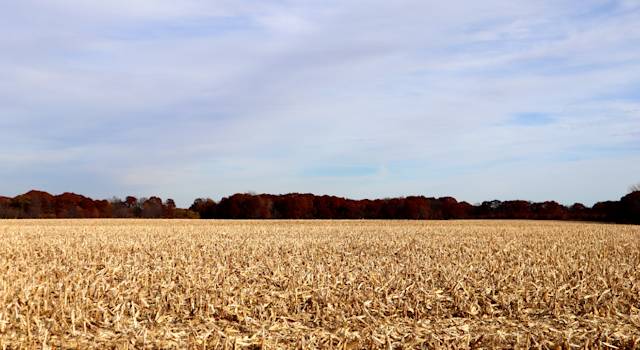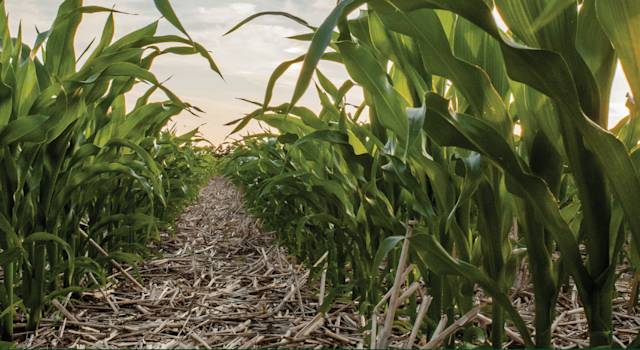
No Till and Water Use Efficiency
Written by: Tyler Williams, ForGround by Bayer Sustainable Systems Agronomist
There are many benefits of utilizng no-till. Here we focus on how no-till practices can not only reduce water loss, but also maximize the water you do have.
No-till farming practices have been growing in adoption in the Corn Belt for quite some time and are a key tool when trying to increase water use efficiency. According to the 2017 USDA Ag Census, over 104 million acres in the U.S. were farmed using no-till practices, up about 8 million acres from 2012. The majority of these acres (53 million) are in the western Corn Belt and Central/Northern Plains states (IA, NE, KS, SD, ND, and MT) where water is often a limiting factor in crop yield.
Using water efficiently in crop production is focused on reducing losses and maximizing the water you do have. No-till farming has been shown to enhance soil bulk density, soil organic carbon, soil porosity, and infiltration of water, as well as reduce surface crusting and evaporation. (1, 2, 3) Leaving the residue on the surface and reducing tillage contributes to enhanced water-use efficiency by getting as much water into the soil and reducing losses to runoff and the atmosphere.
Soil Water Holding Capacity
No-till practices over time can increase the water holding capacity of the soil by influencing soil organic carbon (SOC) and reducing soil disturbance.(2) SOC can retain more water and improve the soil aggregation, increasing the number of larger pores for water to be held. A study in Michigan showed a 32% greater SOC at 3” depth under no-till management compared to conventional till. (4) Results from a long term (40+ years) trial from two sites in Ohio showed the no-till system had 2.0 and 4.2 times higher infiltration rate than minimum tillage and plow tillage, respectively, averaged across both sites. (5) Any soil disturbance can deplete the soil organic carbon and destroy those larger pores, hence, the value in reducing tillage.
Evapotranspiration
Evapotranspiration (ET) is the sum of water leaving the surface through evaporation and through the plants as transpiration and is a good way to assess water use. The ET rate will change due to soil conditions, crop type, crop growth stage, and the environment. Changing those variables, when possible, can be a tool to maximize transpiration and minimize evaporation. In a study from Iowa State in 2017, they showed evaporation accounted for 70% of the total ET in corn from planting to V6, and transpiration accounted from 70% of the ET from V6 to R66. Reducing evaporative losses, especially early in the season, can be critical to conserving moisture for the high water-use growth stages.
Yield Research
Leaving the residue from the previous crop is the primary method to reduce evaporation from the soil surface, which often translates into higher yields in water-limited environments. Studies in Nebraska and Kansas suggested a reduction of 15% total ET when wheat or corn stover completely cover the soil surface from June to the end of the growing season, translating into 2.5- to 3-inch water savings. (7,8) A four-year study conducted in North Platte, NE, showed that residue cover saved more than 2.5 to 5.0 inches of water per year and corn yields were 17 to 25 bushels higher and soybean yields were 8 to 10 bushels higher than in bare-soil plots. (3)
These results are highly dependent on cropping system and environment and expected results can vary in any given year. No-till has been shown to have variable yield results and is more productive in drier environments where water is a limiting factor. (9) There are many other potential benefits attributed to no-till practices and water use efficiency is only one of them.
References
1. Du, X., Jian, J., Du, C., & Stewart, R. (2022) Conservation management decreases surface runoff and soil erosion. International Soil and Water Conservation Research. Volume 10, Issue 2, June 2022, Pages 188-196. https://doi.org/10.1016/j.iswcr.2021.08.001 2. Haruna, S.I., Anderson, S.H. (2020). No-Till Farming Systems for Enhancing Soil Water Storage. In: Dang, Y., Dalal, R., Menzies, N. (eds) No-till Farming Systems for Sustainable Agriculture. Springer, Cham. https://doi.org/10.1007/978-3-030-46409-7_13 3. Williams, T., Bauer, B., Carter, C., Keto, D., Kelley, W., & Vardiman, J. (2017) Using No-Till to Minimize Extreme Weather Impacts. MP-131.2. Jan 2017. University of Wyoming. https://www.wyoextension.org/publications/html/MP131-2/ 4. Robertson, P, Paul, E, Harwood, R. 2000, Greenhouse Gases in Intensive Agriculture: Contributions of Individual Gases to the Radiative Forcing of the Atmosphere. https://doi.org/10.1126/science.289.5486.1922 5. Kumar, S., Atsunobu, K., Lal, R., Warren, D. 2012. Long-Term Tillage and Crop Rotations for 47-49 Years Influences Hydrological Properties of Two Soils in Ohio. October 19, 2012. Soil Science Society of America Journal. 6. Licht, M. & Archontoulis, S. (2017). Corn Water Use and Evapotranspiration. ICM News. Iowa State University Extension. Retrieved from: https://crops.extension.iastate.edu/cropnews/2017/06/corn-water-use-and-evapotranspiration 7. Van Donk, S. (2010) Tillage and Crop Residue Affect Irrigation Requirements. G2000. Irrigation Operations & Management. University of Nebraska – Lincoln. 8. Klocke, N.L., Aiken, R., Currie, R. (2009) Soil Water Evaporation and Crop Residues. Transactions of the ASABE. January 2009. 52(1):103-110. DOI: http://dx.doi.org/10.13031/2013.25951 9. Yang, S., Benoit, G. & Makowski, D. (2021). A global dataset for crop production under conventional tillage and no tillage systems. Scientific Data. 8. 33. 10.1038/s41597-021-00817-x.
Legal Statement ALWAYS READ AND FOLLOW PESTICIDE LABEL DIRECTIONS. Performance may vary, from location to location and from year to year, as local growing, soil and weather conditions may vary. Growers should evaluate data from multiple locations and years whenever possible and should consider the impacts of these conditions on the grower’s fields.
Bayer and Bayer Cross are registered trademarks of Bayer Group. All other trademarks are the property of their respective owners. ©2022 Bayer Group. All rights reserved. 1021_168575


